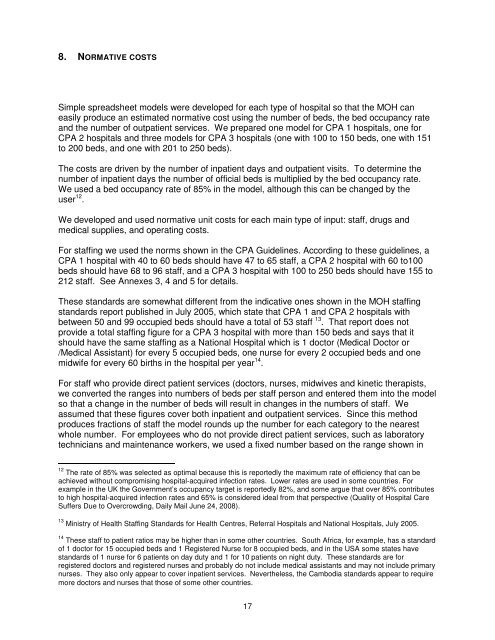Cost Projections for the Complementary Package of Activities - basics
Cost Projections for the Complementary Package of Activities - basics
Cost Projections for the Complementary Package of Activities - basics
You also want an ePaper? Increase the reach of your titles
YUMPU automatically turns print PDFs into web optimized ePapers that Google loves.
8. NORMATIVE COSTSSimple spreadsheet models were developed <strong>for</strong> each type <strong>of</strong> hospital so that <strong>the</strong> MOH caneasily produce an estimated normative cost using <strong>the</strong> number <strong>of</strong> beds, <strong>the</strong> bed occupancy rateand <strong>the</strong> number <strong>of</strong> outpatient services. We prepared one model <strong>for</strong> CPA 1 hospitals, one <strong>for</strong>CPA 2 hospitals and three models <strong>for</strong> CPA 3 hospitals (one with 100 to 150 beds, one with 151to 200 beds, and one with 201 to 250 beds).The costs are driven by <strong>the</strong> number <strong>of</strong> inpatient days and outpatient visits. To determine <strong>the</strong>number <strong>of</strong> inpatient days <strong>the</strong> number <strong>of</strong> <strong>of</strong>ficial beds is multiplied by <strong>the</strong> bed occupancy rate.We used a bed occupancy rate <strong>of</strong> 85% in <strong>the</strong> model, although this can be changed by <strong>the</strong>user 12 .We developed and used normative unit costs <strong>for</strong> each main type <strong>of</strong> input: staff, drugs andmedical supplies, and operating costs.For staffing we used <strong>the</strong> norms shown in <strong>the</strong> CPA Guidelines. According to <strong>the</strong>se guidelines, aCPA 1 hospital with 40 to 60 beds should have 47 to 65 staff, a CPA 2 hospital with 60 to100beds should have 68 to 96 staff, and a CPA 3 hospital with 100 to 250 beds should have 155 to212 staff. See Annexes 3, 4 and 5 <strong>for</strong> details.These standards are somewhat different from <strong>the</strong> indicative ones shown in <strong>the</strong> MOH staffingstandards report published in July 2005, which state that CPA 1 and CPA 2 hospitals withbetween 50 and 99 occupied beds should have a total <strong>of</strong> 53 staff 13 . That report does notprovide a total staffing figure <strong>for</strong> a CPA 3 hospital with more than 150 beds and says that itshould have <strong>the</strong> same staffing as a National Hospital which is 1 doctor (Medical Doctor or/Medical Assistant) <strong>for</strong> every 5 occupied beds, one nurse <strong>for</strong> every 2 occupied beds and onemidwife <strong>for</strong> every 60 births in <strong>the</strong> hospital per year 14 .For staff who provide direct patient services (doctors, nurses, midwives and kinetic <strong>the</strong>rapists,we converted <strong>the</strong> ranges into numbers <strong>of</strong> beds per staff person and entered <strong>the</strong>m into <strong>the</strong> modelso that a change in <strong>the</strong> number <strong>of</strong> beds will result in changes in <strong>the</strong> numbers <strong>of</strong> staff. Weassumed that <strong>the</strong>se figures cover both inpatient and outpatient services. Since this methodproduces fractions <strong>of</strong> staff <strong>the</strong> model rounds up <strong>the</strong> number <strong>for</strong> each category to <strong>the</strong> nearestwhole number. For employees who do not provide direct patient services, such as laboratorytechnicians and maintenance workers, we used a fixed number based on <strong>the</strong> range shown in12 The rate <strong>of</strong> 85% was selected as optimal because this is reportedly <strong>the</strong> maximum rate <strong>of</strong> efficiency that can beachieved without compromising hospital-acquired infection rates. Lower rates are used in some countries. Forexample in <strong>the</strong> UK <strong>the</strong> Government’s occupancy target is reportedly 82%, and some argue that over 85% contributesto high hospital-acquired infection rates and 65% is considered ideal from that perspective (Quality <strong>of</strong> Hospital CareSuffers Due to Overcrowding, Daily Mail June 24, 2008).13 Ministry <strong>of</strong> Health Staffing Standards <strong>for</strong> Health Centres, Referral Hospitals and National Hospitals, July 2005.14 These staff to patient ratios may be higher than in some o<strong>the</strong>r countries. South Africa, <strong>for</strong> example, has a standard<strong>of</strong> 1 doctor <strong>for</strong> 15 occupied beds and 1 Registered Nurse <strong>for</strong> 8 occupied beds, and in <strong>the</strong> USA some states havestandards <strong>of</strong> 1 nurse <strong>for</strong> 6 patients on day duty and 1 <strong>for</strong> 10 patients on night duty. These standards are <strong>for</strong>registered doctors and registered nurses and probably do not include medical assistants and may not include primarynurses. They also only appear to cover inpatient services. Never<strong>the</strong>less, <strong>the</strong> Cambodia standards appear to requiremore doctors and nurses that those <strong>of</strong> some o<strong>the</strong>r countries.17
















